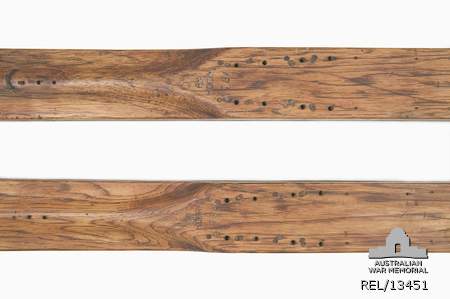| Places | |
|---|---|
| Accession Number | REL/13451 |
| Collection type | Heraldry |
| Object type | Personal Equipment |
| Physical description | Wood |
| Location | Main Bld: World War 2 Gallery: Gallery 1 - Mediterranean: Lebanon-Syria |
| Maker |
Unknown |
| Date made | c 1941 |
| Conflict |
Second World War, 1939-1945 |
Pair of skis : Australian Corps Ski School, Syria




Pair of polished hickory wood skis with 8 mm steel edges screwed to each bottom edge. The underside of each ski also has a central groove running from a point close to the tip to the tail. The upper surfaces of the skis are flat at either end but rise to form a platform in the centre. This flat centre section has 8 holes for bindings on each ski and several older holes which have been filled in. A further three holes are bored into the ridge near the front of the centre section on each ski. Impressed on both central sections is the letter '6' with a smaller, underlined '6' beside it. This number is repeated underneath in faint lettering. The skis are also impressed 'HICKORY 1764' with the word 'HICKORY' repeated again at the heel. 400 mm from the tip are the markings 'A B 2989'. The side of one ski is marked with a broad arrow and the number '4' and there are faint traces of other markings on both skis. The sides of each ski also have three holes on one side and two holes and a filled hole on the other. A further hole has been bored through the end of each ski.
The Australian Corps Ski School was established in the Lebanese mountains of Syria at the end of 1941. The intention was to train Australian troops serving on garrison duty in that country to serve as ski troops, giving them greater mobility in the otherwise almost impassable conditions of the Syrian winter. The school was placed under the command of NX34963 Major (later Lieutenant Colonel) Robert Watkin Savage, a signals officer who was also an accomplished skier and bush walker. A staff of ten, including some of Australia's best skiers, as well as foreigners such as British Olympic competitor Major James Riddell, were brought together to provide expert tuition. Two courses, each of about 50 students, were trained, approximately half being judged competent at the end of their course. The entry of Japan into the war, and changing priorities in North Africa, meant that the Australian ski experiment was short lived. After only three months, the school was closed, and its staff returned to their units. Uniform worn by staff and pupils was sourced locally within Syria, and comprised white canvas trousers and pullover jacket, which were worn over the normal Australian woollen service dress. A white cotton peaked cap and mittens were also supplied. Clothing was waterproofed using a copper sulphate solution which gave the white clothing a characteristic pale blue-green tint.